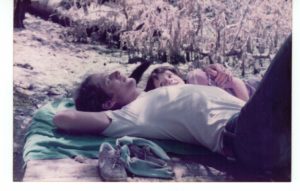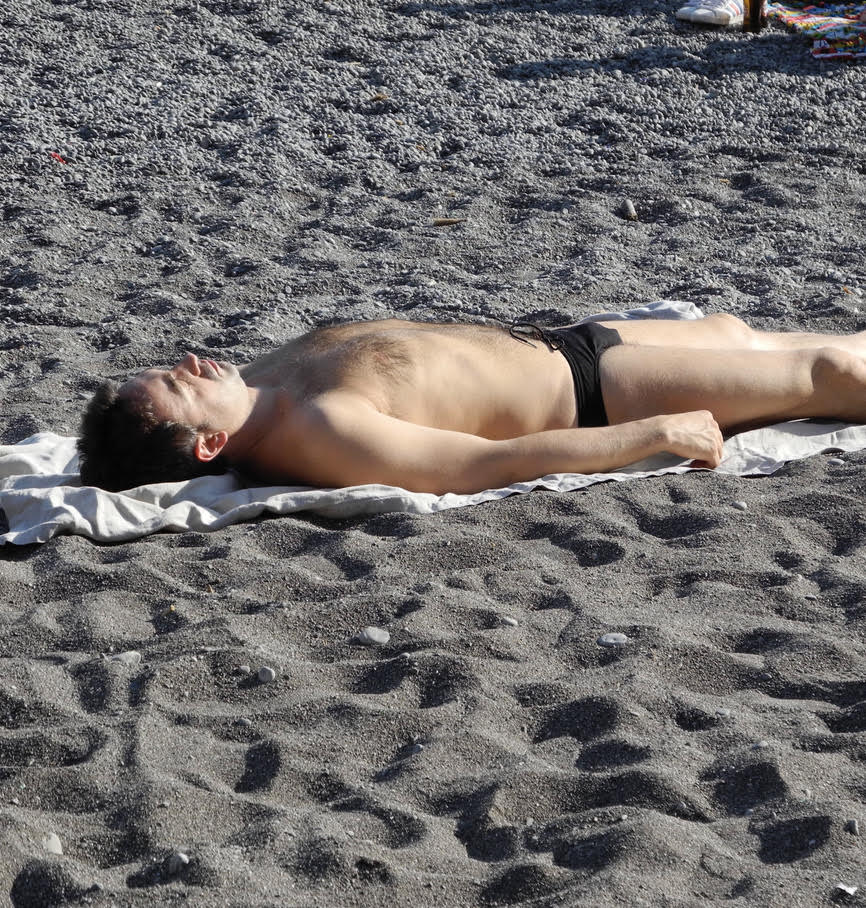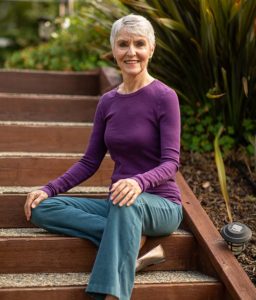Comfort in bed contributes to a good night’s rest.
Are you comfortable when you lie on your back? Or do you feel tension caused by increased curves in your neck and/or your lower back?
“Buckling” is one word for excessive curves in your back.
Painful is another. To buckle something is to distort it, warp it, or bend it out of shape. In the case of our bodies, that means to arch it. Buckling is the reason your back hurts when you wake up in the morning. Do you need to do stretches or exercises before you can get out of bed or walk normally? The culprit is buckling your spine when you sleep.

The man in the photo above is buckling his spine. Note how his lower back arches up off the ground, and his low ribs poke up. His lower back is tight and excessively curved.
What causes buckling?
The short answer is imbalances in the spine: some areas are stiff, others are hyper-mobile. The great majority of us are tight in the thoracic spine, a.k.a. the ribcage. We see it in the mirror is as the rounded upper back, the excessive curve we hate, the one we try to disguise or cover as much as we can. Anatomically speaking, it’s a pronounced thoracic kyphosis.
Since each vertebra is designed to move independently, when two or more vertebrae get stuck together, for whatever reason, something has to give. So other vertebrae, especially in the neck and the lumbar spine, compensate by becoming too mobile. These imbalances destabilize the spine, creating hyper-mobility and stiffness.
Compare the spine in the photo above to the spine below.

This man on the beach in Positano, Italy, has a Balanced spine.
You can see that there is balance in his muscular-skeletal system. He lies on his back as though he were still standing. His low back and neck are “straight” (nothing in the body is truly straight). His chest is broad and full with his lower ribs aligned under his skin. All of these characteristics indicate that there is no stiffness or hyper-mobility that would cause imbalances in his back. He is a picture of comfort and ease.
This sunbather has probably been in Balance all of his life.
He doesn’t know he’s in Balance, just like most people in our culture have no idea their posture is out of Balance. But here’s a clue: when we lie down at the beach or in bed, or in a yoga corpse pose, that yummy relaxation he displays eludes us. Again, compare:

Ouch!
There are a couple of easy ways to tell if your spine buckles when you lie on your back. First, does your chin lift higher than your forehead? In this position, the neck is excessively curved as is evident in the photo. Second, do your ribs lift? If they do, there will be excessive curves and compression in your low back. Unlike the man on the beach who relaxes fully, the woman in the photo above is tense everywhere. Oddly, she may not realize how uncomfortable she is. Her alignment requires tension. To her, tension is “normal,” because she has no comparative experience.
The Good News
The good news about learning and practicing Balance is that as you learn to get comfortable lying on your back, the buckling effect is educated out of your body. Once you make yourself comfortable lying supine you begin to realign your spine, which balances out the stiffness and the hyper-mobility. At every point in your practice of Balance, your comfort is a signpost of skeletal realignment and muscular release.
In class on Friday, you’ll learn how to position your pillows, towels, or yoga blankets so your spine elongates and “straightens.” You’ll feel relaxed and comfortable. Once you get the knack of lying on your back in Balance, the morning aches and pains will disappear and you’ll forget all about those exercises you used to do.
In Friday class, this Friday at noon PT, you can either practice on the floor or in bed. Be sure to have at least two bed pillows handy and a travel pillow if you have one. The class will be interactive so I will check your position if you like.
Everyone who registers for Friday classes is sent a Vimeo recording of each class even if you can’t attend. I get feedback from people who say the class is better live. Even better now that I’ll be giving feedback. Hope you can join me.
~Jean Couch


